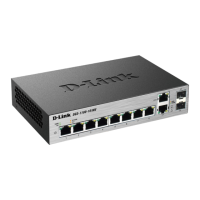Role: Select either UNI or NNI.
UNI – User-to-network interface which specifies that communication between the specified user and
a specified network will occur.
NNI –Network-to-network interface specifies that communication between two specified networks will
occur.
Outer TPID (hex: 0x1-0xffff): The Outer TPID is used for learning and switching packets. The Outer TPID
constructs and inserts the outer tag into the packet based on the VLAN ID and Inner Priority.
Click Apply to implement changes made.
Configuration > IGMP Snooping > IGMP Snooping
With Internet Group Management Protocol (IGMP) snooping, the DGS-1100-10/ME can make intelligent
multicast forwarding decisions by examining the contents of each frame’s Layer 2 MAC header.
IGMP snooping can help reduce cluttered traffic on the LAN. With IGMP snooping enabled globally, the
DGS-1100-10/ME will forward multicast traffic only to connections that have group members attached.
The settings of IGMP snooping are set by each VLAN individually.
Figure 4.52 – Configuration > IGMP Snooping > IGMP Snooping
By default, IGMP is disabled. If enabled, the IGMP Global Settings will need to be entered:
Select the State, Querier State, Querier Version and Fast Leave to be enabled or disabled and then click
Apply for changes to take effect.
Click the Edit button to enter the Querier Timers Settings page.
Figure 4.53 – Configuration > IGMP Snooping > Querier Timer Settings
Host Timeout (130-153025 sec): This is the interval after which a learned host port entry will be purged. For
each host port learned, a 'Port Purge Timer' runs for 'Host Port Purge Interval'. This timer will be restarted
whenever a report message from host is received over that port. If no report messages are received for 'Host
Port Purge Interval' time, the learned host entry will be purged from the multicast group. The default value is
260 seconds.
Robustness Variable (2-255 sec): The Robustness Variable allows adjustment for the expected packet loss
on a subnet. If a subnet is expected to be lossy, the Robustness Variable may need to be increased. The
Robustness Variable cannot be set to zero, and it SHOULD NOT be. Default is 2 seconds.
Query Interval (60-600 sec): The Query Interval is the interval between General Queries sent. By adjusting
the Query Interval, the number of IGMP messages can be increased or decreased; larger values will cause
IGMP Queries to be sent less often. Default value is 125 seconds.
Router Timeout (60-600 sec): This is the interval after which a learned router port entry will be purged. For
each router port learned, a 'Router Port Purge Timer' runs for 'Router Port Purge Interval'. This timer will be

